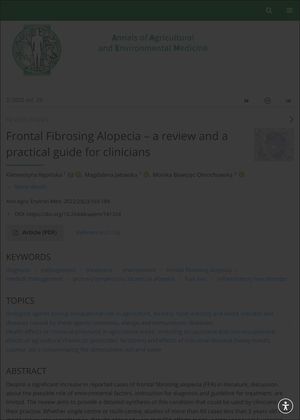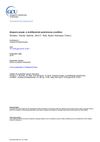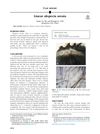Frontal Fibrosing Alopecia: A Review and Practical Guide for Clinicians
August 2021
in “
Annals of Agricultural and Environmental Medicine
”
frontal fibrosing alopecia FFA hyperlipidaemia arterial hypertension osteoporosis hypothyroidism depression dermatological disorders autoimmune genetic hormonal environmental factors facial sunscreens hair dyes shampoo trichoscopy scalp biopsy lichen planopilaris histopathological findings 5α-reductase inhibitors intralesional steroids hydroxychloroquine high cholesterol high blood pressure thyroid disease skin disorders immune system genetics hormones environment sunscreen hair dye 5-alpha-reductase inhibitors steroids Plaquenil

TLDR The article concludes that understanding Frontal Fibrosing Alopecia (FFA) is crucial for effective treatment, which includes medication like 5α-reductase inhibitors and hydroxychloroquine.
Frontal fibrosing alopecia (FFA) mainly affects postmenopausal Caucasian women and is associated with various comorbidities such as hyperlipidaemia, arterial hypertension, osteoporosis, hypothyroidism, depression, and different dermatological disorders. The cause of FFA is thought to be a combination of autoimmune, genetic, hormonal, and environmental factors, including regular use of facial sunscreens and less frequent use of hair dyes and shampoo. FFA can manifest in three specific patterns, each with a different prognosis. Diagnosis is usually made clinically with trichoscopy, but a scalp biopsy is the most reliable method. FFA is considered a variant of lichen planopilaris due to similar histopathological findings, but the clinical presentation is unique and treatment options differ. The most effective treatments for FFA are 5α-reductase inhibitors, intralesional steroids, and hydroxychloroquine. The review emphasizes the importance of a better understanding of FFA for effective disease management.


